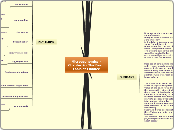Microeconomics - Chapter 9 - The Basic Tools of Finance
Introduction
KEY TERMS
finance
the field that studies how people make decisions regarding the allocation of resources over time and the handling of risk
present value
the amount of money today that would be needed to produce, using prevailing interest rates, a given future amount of money
future value
the amount of money in the future that anamount of money today will yield, given prevailing interest rates
compounding
the accumulation of a sume of money in, say, a bankaccount, where the interest earned remains in the accountto earn additional interest in the future
risk averse
exhibiting a dislike of uncertainty
diversification
the reduction of risk achieved by replacing a single riskwith a large number of smaller unrelated risks
idiosyncratic risk
risk that affects only a single economic actor
aggregate risk
risk that affects all economic actors at once
fundamental analysis
the study of a company's accounting statementsand future prospects to determine its value
efficent markets hypothesis
the theory that asset prices reflect all publicly availableinformation about the value of an asset
informationally efficient
reflecting all available information in a rational way
random walk
the path of a variable whose changes are impossibleto predict
PRESENT VALUE: MEASING THE TIME VALUE OF MONEY
present value
Questions
First Example
Q: What is the Future value of $100in N years
A: Assume 10 years at 5%
( 1.05 )^10 x 100
$163
Second Example
If r is the interst rate, then an amount X to be recieved in N years has present value of X / ( 1 + r )^N
MANAGING RISK
Risk Aversion
The Markets for Insurance
annuity
adverse selection
moral hazard
Diversification of Idiosyncratic Risk
standard deviation
The Tradeoff between Risk and Return
ASSET VALUATION
Fundamental Analysis
undervalued
overvalued
fairly valued
dividends
The Efficient Marktes Hypothesis
Market Irrationality
SUMMARY
Because savings can earn interst, a sum of moneytoday is more valuable than the same sum of moneyin the future. A person can compare sums from differenttimes using the concept of present value. The present value of an future sum is the amount it would be needed today,given prevailing interest rates, to produce that future sum.
Because of diminishing marginal utility, most people are riskaverse. Risk-averse people can reduce using insurance, throughdiversification, and by choosing a portfolio with lower risk andlower return.
The value of an asset, such as a share of stock, equals the presentvalue of the cash flows the owner of the share will recieve, includingthe stream of dividends, and the final sale price. According to the efficientmarkets hypothesis, financial markets process available information rationally,so a stock price always equals the best estimate of the value of the underlyingbusiness. Some economists equestion the efficient markets hypothesis, however,and beleive that irrational psychologyical factors also influence asset prices.
FORUMALS
compounding
( 1 + r )^n x P
Where:r = interest raten= yearsP = starting
rule of 70
EXTRA READING
FYI
The Magic of Compoundingand the Rule of 70
CASE STUDY
RANDOM WALKS AND INDEX FUNDS
In the News
Some Lessons From Enron
Investors Behaviour Clouds the Wisdom of Offering Wider Choice in 401(k)'s
LEARNING OBJECTIVES
Measure the value of money at different points in time
Learn how to manage risk
Examine what determines the value of an asset
MODELS
The Utility Function - F9.1
Diversification Reduces Risk - F9.2
Subtopic
The Trade off Between Risk and Return - F9.3
TESTING POINTS
Quick Quiz
Question 1
The interst Rate is 7 percent.What is the present value of $150 to be recievedin 10 years?
Question 2
Describe three ways that a risk-averse person might reduce the risk she faces
Question 3
Fortune magazine regularly publishes a list sof the "most respected"companies. According to the efficient markets hypothesis, if you restrict yourstock portfolio to these companies, would you earn a better then average return?
explain
Questions for Review
